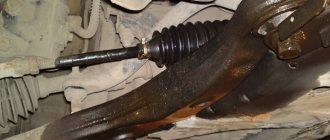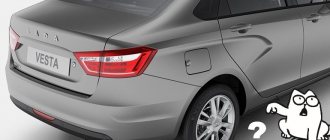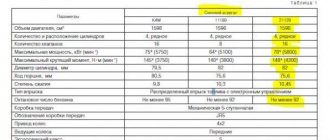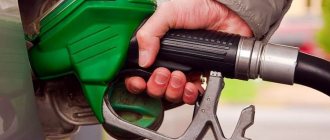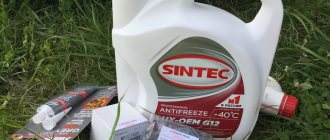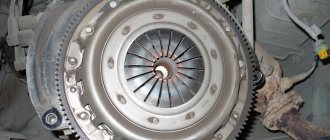Car : Lada Kalina. Asks : Ivanov Sergey. The essence of the question : What kind of gasoline is better to fill in the Lada Kalina?
Good afternoon, please tell me what is the best way to fill the Lada Kalina with gasoline? I doubt my choice because there are disagreements between official sources and reviews from Kalina owners. They say that with 92 gasoline the fuel consumption of the Lada Kalina is higher, and the engine does not drive as dynamically.
Which gasoline is better: 92 or 95?
Some car brands support both 92 and 95 types of gasoline. In order to find out whether there is any significant difference between these types (and whether it is permissible to refuel a car for which the octane number recommended by the manufacturer is 95, 92 type), you first need to clarify the issue regarding the octane number. How does the functioning of the internal combustion engine depend on it?
There is an opinion that the type of gasoline clearly determines the quality of the fuel - higher means better, and the mixture burns more efficiently. However, this is not true. The first thing on which the combustion efficiency of the mixture depends is the engine itself - to be more precise, its adaptation to 92 or 95 type gasoline. After all, an increase in the octane number determines the duration of combustion of the mixture, but, what is even more significant, the power (due to the fact that combustion begins in the case of greater compression).
Due to the fact that the 95 is able to endure greater pressure before it begins to burn (unlike the 92), it is able to burn longer, which is an additional increase in the power of the machine. However, if the engine is not adapted to work with high-octane gasoline (or vice versa, with gasoline of a lower octane number than that recommended by the manufacturer), the engine efficiency, on the contrary, will decrease significantly - and this is clearly felt. This occurs due to premature detonation of gasoline with a low octane number, which ultimately does not burn completely.
In other words, when choosing fuel to fill the gas tank, the first thing to consider is what type of gasoline the car manufacturer recommended. Next, we will take a closer look at whether or not it is worth using different types of fuel for a number of cases.
The manufacturer recommended both 92 and 95
Some car models (it would be more correct to say “some designs of the engines of these cars”) allow you to refuel the car with both 92 and 95 types of gasoline. For example, a large list of mid-size sedans and crossovers (Hyundai Solaris, Toyota Corolla, Kia Rio, etc.) allows the use of both types of gasoline.
However, the question arises - which type is preferable? We can answer unequivocally – type 95. Longer combustion means increased efficiency. Moreover, in this case it is not always planned to accelerate faster or provide increased speed.
On the contrary, it is necessary to fill in 95-grade gasoline, adhering to the current driving style and dynamics solely for the purpose of saving fuel.
For this reason, often the increased price of 95 gasoline ends up being offset by its reduced consumption (of course, if the engine is adapted for this type of fuel). Diesel engines, however, will in any case be even more economical.
A huge number of drivers specifically fill their cars with type 92 instead of 95 - according to them, 95 gasoline is the same as 92, and the higher octane number is simply due to the use of a bunch of additives. But additives certainly won’t harm the engine, because they often affect the compression time before ignition begins. Although we note that a number of additives that may contain low-quality gas stations can really harm the car. Hence the conclusion - refuel the gas tank only at proven stations. Otherwise, you may experience a difference in driving dynamics as well as a change in engine sound.
But if the manufacturer recommends both types of gasoline, it is quite acceptable to fill the car with 92nd. Almost all new engines are able to adapt to the fuel mixture themselves, shaping the ignition timing in the event of premature detonation. Being installed on such cars, the knock sensor, when premature ignition is detected, shifts the advance angle to a smaller side, stabilizing the functioning of the engine.
92 instead of 95
You are probably aware that the fuel mixture in the engine ignites due to the supply of a spark by a spark plug at a specific point in time, determined by the operation of the 4-stroke cycle, due to which the mixture burns in the most optimal way. Gasoline with a low octane number ignites more quickly, creating a less stable combustion in an internal combustion engine with a high compression ratio. As a result, premature (or irregular) ignition of the fuel mixture in the combustion chamber can lead to a clearly audible knocking sound from under the hood - this is the so-called.
detonation, the cause of which is precisely the incomplete combustion of the gasoline mixture - moreover, it can burn out already in the exhaust system, namely in the catalytic converter. As a result, the metal parts of this device are sintered, and replacing the neutralizer is expensive. Although in reality the difference will almost always not be felt, only a slight increase in fuel consumption and a decrease in power. How is it that you filled the tank with 92 gasoline to save money? It’s very simple - 92 gasoline can burn less efficiently.
The reduction in power will be especially noticeable during dynamic driving (on the highway, for example).
Moreover, if you periodically pour 92 gasoline into the tank instead of 95, the result may be early wear of the engine and failure of the catalyst.
What's better?
AI-92 differs significantly from AI-95, but in general use, for the average car owner, the difference is practically unnoticeable. Everyone only knows that the markings “92” and “95” display the octane number and, accordingly, emphasize the detonation properties. But she doesn't say that the fuel is good.
In addition, much depends on the method of gasoline production. Thus, two different fuels purchased at neighboring gas stations will be completely different when tested by laboratory research methods. Much depends on the integrity of the manufacturer and the method of direct distillation of oil used. This is especially true for the presence of high sulfur content; the higher it is, the faster the car will “die.”
Measuring the octane number of gasoline
Factory standard fuel consumption indicators for Lada Kalina
There are four main models of the Lada Kalina passenger car:
- sedan - has a closed body, with 2-3 rows of seats for the driver and passengers, the trunk is separated from the car interior, there is no lifting door in the rear wall;
- station wagon - has a closed cargo-passenger body, one of the sedan variants, which has an enlarged luggage compartment, is equipped with a lifting door in the rear wall;
- hatchback - has a body with 1-2 rows of driver and passenger seats, with a shortened rear overhang (hence the name - “hatchback” means “short”) and a smaller luggage compartment, equipped with a lift-up door in the rear wall;
- sport - is a sports version, which is equipped with a number of special parts - a bumper, an exhaust pipe tip, sports pedals, alloy wheels, a SAAZ Sport sports suspension, front and rear disc brakes, an original reinforced gearbox.
As you can see, the main difference between each model is its body type. Gasoline consumption (unleaded AI-95) is calculated in liters over a driving cycle, which is 100 kilometers.
In this case, the following parameters of the vehicle itself are taken into account:
- Engine size (Lada Kalina comes in two types - 1.4 l and 1.6 l).
- Number of valves (for Lada Kalina - 8 and 16).
Experts have prepared an information table that shows the factory fuel consumption indicators for each model of the Lada Kalina passenger car, taking into account the mandatory parameters.
| Model Lada Kalina | 1.6 l (8 valves) | 1.6 l (16 valves) | 1.4 l (16 valves) |
| sedan | 7,8 | 7,2 | 7,0 |
| station wagon | 7,3 | 7,2 | 7,0 |
| hatchback | 7,3 | 7,3 | 7,0 |
| sport | – | 7,8 | – |
The manufacturer sets the standards for digital fuel consumption indicators for each Lada Kalina model based on the results of test runs of passenger cars on a special track. But on the track, driving conditions are reduced to ideal, and the car is driven by an experienced driver. In real conditions, everything becomes much more complicated. In addition, the speed indicator during real driving is not always within the required limits - from 100 km/h to 120 km/h. This is due to the fact that some drivers do not recognize the established framework for optimal driving of a Lada Kalina car, which significantly affects fuel costs.
First generation
The first sedan car went on sale in 2004; the car was equipped with a 1.4 liter engine with 89 horsepower. Fuel consumption of Lada Kalina 1118 (factory designation) had the following values:
- City - 9.6 l. per 100 km.
- Route – 6.3 l. per 100 km.
- Mixed pace - 7.8 l. per 100 km.
It should be noted that in 2009 the production of the first generation of LADA Kalina sedans was suspended, but within a few months the cycle was established, and until 2011 this model was produced by the AvtoVAZ concern.
Hatchbacks went on sale a little later, towards the end of 2006, and then production of the Lada Kalina (1119) was launched. These cars, as well as sedans, began to be equipped with a more powerful engine, which had a 1.6 liter fuel compartment and was produced with a power of 81 hp and 98 hp. According to the requests of the factory developers, which corresponded to the reviews of the owners, the car with an 81-horsepower engine had the following fuel consumption indicators per hundred kilometers:
- City - 10.2 l.
- Route – 6.6 l.
- Mixed temp – 7.4 l.
As for the 98 horsepower engine, the consumption per hundred kilometers of road under different conditions is:
- City - 9.7 l.
- Route – 6.4 l.
- Mixed temp – 7.1 l.
Only in 2007, the automobile concern rolled out the Lada Kalina with a station wagon (1117), its fuel consumption parameters are approximately the same as those of cars in other bodies, except that when driving in the city it consumes 200-300 grams. more gasoline.
One of the branches produced in limited series was the LADA Kalina Sport (11196), this car was released in 2008. Her gasoline consumption figures per 100 km are:
- City - 9.4 l.
- Route – 6.7 l.
- Mixed pace - 8.9 l.
Like the entire first series, LADA Kalina Sport ceased production in mid-2013.
Real data, according to owner reviews
- Victor, Saratov. I've been driving this car for a long time, everything has happened, except serious accidents, and I've gotten to know the car well. There are weaknesses in the body; the front arches began to rot especially quickly. But the engine is reliable, provided of course you use high-quality gasoline, oil and coolant. Lada Kalina with a 1.4 liter 16-valve engine has average fuel consumption. I drive mostly around the city and, as before, I pour ten liters per hundred kilometers in heavy traffic.
- Sergey, St. Petersburg. I bought a Kalina hatchback for maneuverable driving around the city while working. In 2010, I made a choice in favor of the 1.6 liter 16 valve version, and I think it was right. The car is really nimble, and the fuel consumption on this Kalina is even lower than on its less powerful brothers in the shop. Of course, very often you have to get stuck in traffic jams, so the figure of 11 liters per 100 km does not seem significant.
- Stepan, Ufa. I bought a good station wagon from the domestic auto industry first-hand in 2013; at that time the car was in good condition, although the struts were already knocking. During operation, everything else began to crumble, including the engine. The workshop said that I often filled with low-quality fuel, this seems to be true, the gas station near my house does not belong to any of the well-known networks. Kalina's consumption per 100 km is approximately 11-12 liters in the city, but on the highway maybe a little less, I didn't measure it.
- Yaroslav, Kazan. I live on the outskirts of the city and my work is shift work, so I can avoid major traffic jams and get to my destination with minimal fuel loss. Therefore, my sedan’s fuel consumption per hundred kilometers is slightly less than 9 liters. Otherwise, I am also completely satisfied with the Lada Kalina; she feels confident both off-road and on high-speed sections of the highway.
- Alexander, Konstantinovka. Buying a 1.6 liter Lada Kalina. and 8 valves, was not the best investment. I was guided then by the advice of my comrades, they say, this motor is the most reliable. In fact, the breakdowns were not long in coming, although they were minor, but I think others fail just as often. But the gasoline consumption of a car with such an engine is the highest; it simply does not have enough power to gain speed confidently. So it turns out that even on the highway she eats at least 9 liters per hundred square meters.
AI-80
These, of course, were not experiments of their own free will, but my Kalina had to drive a couple of times even on the AI-80, which does not fit in with injection engines at all. There were cases when gas stations along the highway did not have other types of fuel, and therefore we had to get to the next station using what we had. But, to be honest, when after filling five liters of this fuel into a completely dry tank, the car felt the same as on the 95th, I was simply shocked. Everything remained at the same level, consumption, acceleration and other characteristics. Of course, I did not intend to carry out further such experiments, who knows what long-term operation would show, but the fact remains a fact.
How to check fuel quality
In order to at least slightly protect Vesta from refueling with low-quality fuel in “camping” conditions, it is necessary to visually evaluate the fuel. High-quality AI-95 must be either almost transparent or have a slight blue or yellow tint.
High-quality fuel has a light tint.
If gasoline has a reddish tint, you should refuse to refill, as this indicates metal-containing additives (based on manganese or ferrocene). This is also true for gasoline with a bright yellow color - there is an additive based on monomethylaniline.
It is better to stay away from fuels with a red tint.
In general, it is better to refuel only at trusted stations equipped with expensive imported equipment. Although this does not give a 100% guarantee. You also need to look at the information on the receipt. The fact is that many gas stations illegally use the symbols of famous brands. For example, on a genuine Lukoil check, “Restland LLC” must be written. There should be no other designation.
“Restland LLC” - this is exactly the designation that should be on Lukoil’s check.
And the most important piece of advice is that you shouldn’t skimp on refueling your Lada Vesta. Filling up with gasoline is 2 rubles cheaper, and you can pay for it by having the engine overhauled. This is proven by investigations by journalists when cheaper gasoline from dubious gas stations turns out to be 80 rather than 95.
The presented story offers several simple tips for independently checking the quality of fuel:
What kind of gasoline should I put in the Lada Granta: 92 or 95?
Very often, car owners wonder what kind of gasoline to fill in Granta: 92 or 95. Sometimes, even before buying a domestic car, a motorist asks the question what brand of gasoline to fill in his future car.
In fact, it is very difficult to understand which gasoline is suitable for which car brand. Most often, drivers cannot choose between AI-92 and AI-95. It is absolutely normal that everyone is trying to save money, and even more so on gasoline, on which you have to spend a large percentage of your salary every month.
Based on this, most motorists choose AI-92. If you compare the price per liter of AI-92 and AI-95, the difference will seem insignificant, but if you multiply the price per liter by the number of liters of gasoline that is consumed during the month, the difference is significant.
If you visit a car service center and ask a question about what gasoline is suitable for the Lada Granta, you will receive the answer that the car must be refueled according to the recommendations of the company that produces this brand of car.
How does the car manual answer this question?
So, to answer the question of whether it is possible to fill Granta with 92 gasoline, which worries many motorists, you should open the instructions on Appendix 1, which states that the recommended gasoline is “Premium 95” or “Premium Euro 5”. Why do the instructions contain such strict restrictions regarding gasoline?
Let's figure it out. The first note states that the required flammability at low temperatures must be ensured.
It follows from this that fuel must be selected of a certain volatility class. In different regions of the Russian Federation, this requirement is adhered to differently, and fuel volatility classes differ from each other based on location.
The second obstacle to the use of low-octane gasoline is various metal and organic particles, which are anti-knock agents and are contained in gasoline. The presence of lead, cadmium, manganese, iron and other metals can be observed in the particles.
Various additive materials are introduced into high-octane gasoline to prevent the formation of soot, various deposits and corrosion. But these substances can only be included in gasoline by its manufacturer. Every motorist can do this, but experts do not recommend doing this, since substances can be introduced in the wrong proportion.
What do drivers think about this?
If you read the reviews of the Lada Granta owners themselves, you may encounter some contradictions. Some argue that AI-92 gasoline is perfect for Lada, except that detonation appears in the combustion chamber.
Other drivers argue that only AI-95 is suitable for the Lada Granta, and even note that it is this gasoline that helps save on fuel consumption.
This octane number of gasoline has a positive effect on the fuel consumption of a car. If the average speed of a car is from 90 to 100 km/h, using 95 gasoline, about 5.5 liters of gasoline are consumed.
There is a third group of car owners who fill the tank with gasoline of both brands, which is why the results are not very good. Drivers mix two types of gasoline in order to reduce detonation and average gasoline consumption, but experts still do not recommend mixing different types of gasoline.
Car owners who buy AI-92 do not see a significant difference in the car's dynamics, engine performance and gasoline consumption. If you replace the fuel recommended in the instructions for use with AI-92, then the only difference will be the effect on the fuel system.
Is it possible to fill Grant 92 with gasoline?
Other car enthusiasts claim that they see no difference between using AI-92 and AI-95, and the engine in both cases will work almost the same. But everyone knows that using 92-octane gasoline leads to contamination of the engine system and spark plugs.
But, without taking this fact into account, many Russian motorists advise filling the Lada Granta with AI-92. Let's figure out whether the Lada Granta 92 can be filled with gasoline.
Many oil refineries located in Russia do not have the technologies and equipment that can produce high-quality 95-A gasoline.
Therefore, to create 95-grade gasoline, specialized additives are used that gasoline contains. The more such additives are contained in gasoline, the more negative the impact of the use of such gasoline on the operation of the engine and the entire vehicle system.
Well-made pure 92-A gasoline is much more suitable for any car, including the Lada Granta. There are still several factories in the Russian Federation that produce high-quality gasoline up to 98.
Most motorists advise you to familiarize yourself with information about gas stations that are in your city in order to understand what type of gasoline to buy. You should find out where these gas stations purchase fuel, as well as who produces this gasoline and what quality it is.
If you read this information in advance, you will be able to avoid problems that may arise with the engine due to the use of low quality fuel.
So, gasoline 92-A has the following features:
• leads to contamination of the engine system and spark plugs;
• has low cost;
• does not negatively affect the dynamics of the car;
• does not affect engine operation.
All motor oils recommended for use
Engine oil is usually replaced along with a paper filter. This consumes 2900 ml of fluid (for versions with automatic transmission – 4100 ml). The intervals between replacements are indicated in the service book. Recommended materials for use:
| Brand | Viscosity SAE | Quality |
| Lukoil LUX | 15W40 | SL/CF (B5/D3) |
| Lukoil LUX semi-synthetics | 5W30, 5W40, 10W40 | SL/CF (B5/D3) |
| Lukoil LUX synthetic | 5W30, 5W40 | SN/CF (B6/D3) |
| Rosneft MAXIMUM (Angarsk, Novokuibyshevsk) | 5W40, 10W40 | SL/CF (B5/D3) |
| Rosneft PREMIUM (Angarsk) | 5W40 | SM/CF (B6/D3) |
| TNK MAGNUM SUPER | 5W30, 5W40, 10W40, 15W40, 15W50 | SL/SJ/CF (B5/D3) |
| Gazpromneft PREMIUM | 10W40 | SL/CF (B5/D3) |
| G-ENERGY S SYNTH, F SYNTH | 5W40, 10W40 | SL/CF (B5/D3) |
| G-ENERGY EXPERT L | 5W30, 5W40, 10W40 | SL/CF (B5/D3) |
| GT TURBO SM (Hanval INC) | 10W40 | SM (B5) |
| ESSO ULTRA | 10W40 | SL/SJ/CF (B5/D3) |
| MOBIL 1 ESP FORMULA | 5W30 | SN/SM/CF (B6/D3) |
| MOBIL 1 NEW LIFE, PEAK LIFE, SUPER 3000 X1 | 0W40, 5W40, 10W40, 5W50 | SN/SM/SL/SJ/CF (B6/D3) |
| MOBIL SUPER 2000 X1 | 0W40, 5W40, 10W40, 5W50 | SL/SJ/CF (B5/D3) |
| SHELL HELIX PLUS | 5W40, 10W40 | SL/CF (B5/D3) |
| SHELL HELIX ULTRA, HX7, HX8, PLUS EXTRA | 5W40, 10W40 | SM/CF (B6/D3) |
| ZIC A PLUS | 5W30, 10W30, 10W40 | SL (B5) |
To narrow the range of choices, be guided by the climatic conditions in which the car will be used. It is recommended to determine the viscosity class based on air temperature:
| lower limit | Viscosity grade | Upper limit |
| –35 and below | 0W40 | +30 |
| –30 | 5W30 | +25 |
| –30 | 5W40 | +35 |
| –25 | 10W30 | +25 |
| –25 | 10W40 | +35 |
| –20 | 15W40 | +45 |
| –20 | 20W50 | 45 and above |
It is recommended to change the oil at a service station (service station). , however, the owner himself can add liquid to the tank.
Adding oil to the expansion tank
The oil level is controlled as follows: when the engine is turned off, unscrew the diagnostic dipstick located near the cylinder head cover between the third and second cylinders. A secondary check is carried out no earlier than after 3–5 minutes. after topping up.
The factory usually fills it with semi-synthetic material with a viscosity of 5W30 produced by Rosneft OJSC. Check the information by opening the service book.
Oil type
Lada Kalina engines support various types of oils - synthetic and semi-synthetic. The use of mineral oils is not recommended, according to the manufacturer's recommendations. Moreover, this is an instruction not only from AvtoVAZ, but also from the Association of Automobile Manufacturers.
For reference, we note that the need for mineral lubrication disappeared after more modern injection engines appeared, replacing carburetor engines. Experts have come to the conclusion that the “mineral water” does not have any special value, but only creates carbon deposits on the walls of the combustion chamber. But this is a recommendation for injectors, while older carburetors are still more optimized for mineral oil.
Markings
Let's look at oil manufacturers, as well as markings that can help you find out whether Lada Kalina supports a particular oil.
- Lukoil Lux. SAE class – QW-40, 10W-40, 5W30; group – SL/CF
- Luxe Hit/Best. SAE class – 10W-40; group – SL/CF
- Novile Super. SAE class – 5W-30, 20W-50, 15W-30; SJ/CF
- Rosneft Maximum/Premium. SAE class – 5W-40, 10W-40, 5W-40; SL/CF
- Tatneft Synthetic/Ultra. OW-40, 5W-30, 5W-40; SM/CF, SL/CF
- Esso Ultra. 10W-40, SJ/SL/CF
- Mobil 1.OW-40, 5W-50, 10W-40; SJ/SM/SL/CF
- Shell. 5W-40, 10W-40; SL/CF
- ZIC A. 5W-30, 10W-30; SL
As you can see, Lada Kalina owners have a wide selection of oils with different classes and standards. Based on these standards, a car enthusiast can safely fill in any oil from the specified list.
Deciding what gasoline to fill the VAZ 2114 with
Many motorists, especially those buying a car for the first time, are faced with a completely logical question - which gasoline is better for the VAZ 2114?
It does not arise by chance, because very often the information received by the car enthusiast contradicts each other. So, the passport of this model clearly states 95 gasoline, but many drivers and even employees of car dealerships and auto repair shops strongly recommend driving 92 gasoline. What to do in this situation?
First, let's turn to the opinion of many experts - when traveling within the city (that is, when driving with frequent stops and at lower speeds), it is better to use 92 gasoline, and when driving on the highway - 95. This recommendation is caused by the peculiarities of engine operation in different modes. For the same reason, it is recommended to refuel 92 in the cold season, and 95 in the warm season.
Pouring gasoline into a VAZ 2114
By following such recommendations, you can be sure of optimal fuel consumption and smoother operation of the car. True, some may object - what to do if there is no desire to change fuel when leaving the city on the highway or vice versa? Shouldn't you pour different fuels into one tank?
Yes, pouring gasoline of different brands into the tank at the same time is highly not recommended. For this reason, many motorists still choose one type of fuel. But which one exactly is up to everyone to decide for themselves.
The fact is that significant differences in gasoline brands are a thing of the past - previously, gasoline was produced using special additives that could increase the octane number (the so-called leaded gasoline), and running cars on the “wrong” gasoline could cause them to wear out quickly. Currently, such fuel is prohibited and is not used, so you can refuel a car with both 92 and 95 gasoline.
The real quality of gasoline (sometimes significantly different from gas station to gas station) is much more important than the octane number indicated in its name.
Advice from motorists
Often, car owners try to listen to the advice of other drivers, including on the issue of how to refuel a VAZ 2114. True, the advice here is radically different - one half drives a 92 and praises it, the other is in favor of a 95, because that’s what’s written in the passport and this is right".
In such a situation, it is worth recalling the above phrase once again - a difference of 3 octane units is quite insignificant and is poorly perceived by both the car and its driver (in the latter case, most opinions like “better are subjective”). An objective assessment here could be fuel consumption or the degree of wear of some elements, but they are almost the same (of course, there is a difference, but it is very small).
It is for this reason that we can say with confidence that it does not matter what kind of gasoline is poured into the VAZ 2114 - 92nd or 95th, what is much more important is not its octane number, but its quality.
How to tell the difference?
So, the main difference between AI-95 and AI-92 fuel is the octane number. Fuel labeling allows you to assess the risk of ignition. A low octane number of fuel indicates that it is explosive. The difference in values is minimal, only 2-3 units, so the differences are insignificant.
There are many myths on this issue. For example, when refueling AI-95 instead of the recommended AI-92, the valves may suffer. Or the fact that when driving an AI-95, car owners have to change spark plugs more often. Such problems do occur, but they have nothing to do with the markings. Breakdowns of consumables are possible if the manufacturer neglected the basic rules of preparation and processing, therefore, the buyer received low-quality fuel.
Consequences of using low-quality gasoline
It is impossible to find differences between products of different brands at home, that is, to establish a specific octane number. This requires a research laboratory.
Craftsmen suggest doing this by color, relying on the fact that AI-95 contains redness, and AI-92 is purely yellow (straw). But such methods do not have a scientific basis, since the shade can change depending on the additives used.
Reasons for high fuel consumption
It is believed that Kalina’s consumption of gasoline, high fuel consumption, has objective reasons, but this is not always the case. There are situations in which the owner himself is to blame for increased fuel costs, among them:
- Aggressive driving style - unreasonable acceleration on busy sections of the road, leads to increased costs, driving on the highway at the maximum speed for a car also causes unnecessary losses. On an open road, you should not exceed the cruising speed of 90-110 km/h.
- Untimely maintenance - failure or clogging of some components responsible for supplying gasoline to the combustion chamber leads to increased consumption. Wear of the piston system, like
- Viburnum, like other car brands, is also a common cause of high fuel costs. Poor quality fuel - you should not trust unverified gas stations, especially if they do not have known identification marks.
Based on the information provided, we can conclude that the Lada Kalina, like any other car, has a number of disadvantages, but it also has advantages, so you should weigh the pros and cons before purchasing.



